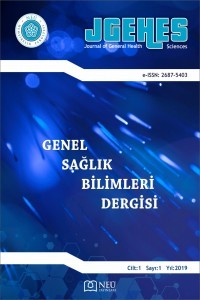Kadınların Kullandıkları Aile Planlaması Yöntemini Değiştirme Nedenleri
Aile Planlaması, Kontraseptif Yöntem, Üreme Sağlığı Hizmetleri
Reasons for Changing the Family Planning Method Women Use
___
- Bitzer, J, Gemzell-Danielsson K, Roumen F, Marintcheva-Petrova M, van Bakel B, & Oddens BJ (2012) The CHOICE study: Effect of counselling on the selection of combined hormonal contraceptive methods in 11 countries. Eur J Contracept Reprod Health Care 2012, 17:65–78. https://doi: 10.3109/13625187.2011.637586.
- Gavas, E, & İnal, S (2019). Türkiye’de kadınların aile planlaması yöntemleri kullanma durumları ve tutumları: Sistematik derleme. Sağlık Ve Yaşam Bilimleri Dergisi, 1(2), 37-43. https://doi.org/10.33308/2687248X.201912118
- Gosavi A , Ma, YMBBS, Wong H, & Singh, K (2016) Knowledge and factors determining choice of contraception among Singaporean women Singapore Med J 57(11): 610-615 https://doi: 10.11622/smedj.2015181
- Johnson S, Pion C, & Jennings V (2013). Current methods and attitudes of women towards contraception in Europe and America. Reproductive Health 10:7. https://doi:10.1186/1742-4755-10-7
- Morris, C. N., Lopes, K., Gallagher, M. C., Ashraf, S., & Ibrahim, S. (2019). When political solutions for acute conflict in Yemen seem distant, demand for reproductive health services is immediate: a programme model for resilient family planning and post-abortion care services. Sex Reprod Health Matters, 27(2):1610279. https://doi: 10.1080/26410397.2019.1610279.
- Rosales C, Mansour D, & Cox M (2012). Does current contraceptive choice correspond with user satisfaction? J Obstet Gynaecol 32:166–172. https://doi: 10.3109/01443615.2011.638998.
- Sköld A, Larsson M (2012). Contraceptive use during the reproductive lifecycle as reported by 46-year-old women in Sweden. Sex Reprod Health,3:43–47. https://doi: 10.1016/j.srhc.2011.11.004. Epub 2011 Dec 7.
- TNSA (2018) http://www.hips.hacettepe.edu.tr/tnsa2018/rapor/TNSA2018_ana_Rapor.pdf Ulaşım 20 Mart 2020
- Torres-Pereda P, Heredia-Pi IB, Iba´ñez- Cuevas M,A´ vila-Burgos L (2019) Quality of family planning services in Mexico: The perspective of demand. PLoS ONE 14(1): e0210319. https://doi. org/10.1371/journal.pone.0210319
- United Nations Population Fund (UNFPA) Amid grinding conflict, Yemen’s midwives go to heroic lengths to save lives. New York (NY: ): UNFPA; 2018. https://www.unfpa.org/news/amid-grinding-conflict-yemens-midwives-go-heroic-lengths-save-lives Ulaşım 20 Mart 2020
- United Nations Population Fund (UNFPA), Government of Yemen. Country Programme Action Plan (CPAP), 2012 −2015 New York (NY: ): UNFPA; 2012. https://www.unfpa.org/data/transparency-portal/unfpa-republic-yemen Ulaşım 20 Mart 2020
- Yayın Aralığı: Yılda 3 Sayı
- Başlangıç: 2019
- Yayıncı: Necmettin Erbakan Üniversitesi
Yetişkin Bireylere COVID-19 Pandemisinin Sağlık Algısı Üzerine Etkisi
Ganime Esra SOYSAL, Ümmühan YİĞİT
Yenidoğanda Ağrı Yönetimi ve Hemşirelerin Rolleri
Büşra İNAÇ YILMAZ, Nevin KANAN
Biyotikler Ailesinin Yeni Üyesi: Postbiyotikler
Çocukların Fiziksel Aktivite, Obezite Düzeylerinin İncelenmesi: Kayseri İli Örneği
Meltem YAZICI-GÜLAY, Zübeyde KORKMAZ, Zeliha KAYA ERTEN, Kaan GÜRBÜZ
Kadınların Kullandıkları Aile Planlaması Yöntemini Değiştirme Nedenleri
Tuba Esra ŞAHLAR, Kemal Macit HİSAR
Ali KELEŞ, Mehmet Tuğrul YILMAZ, Cengiz KADIYORAN
Lösemili Hastaların Yaşam Kalitesi ve Sosyal Destek Düzeylerinin Değerlendirilmesi
Evli Kadınların Gebe Kalmaya Yönelik Geleneksel İnanç ve Uygulamaları
Zehra ACAR, Mehtap GÜMÜŞAY, Nevin HOTUN ŞAHİN
COVID-19 Pandemi Sürecinde KOAH Olan Bireylerin Yaşam Deneyimleri: Nitel Bir Çalışma
